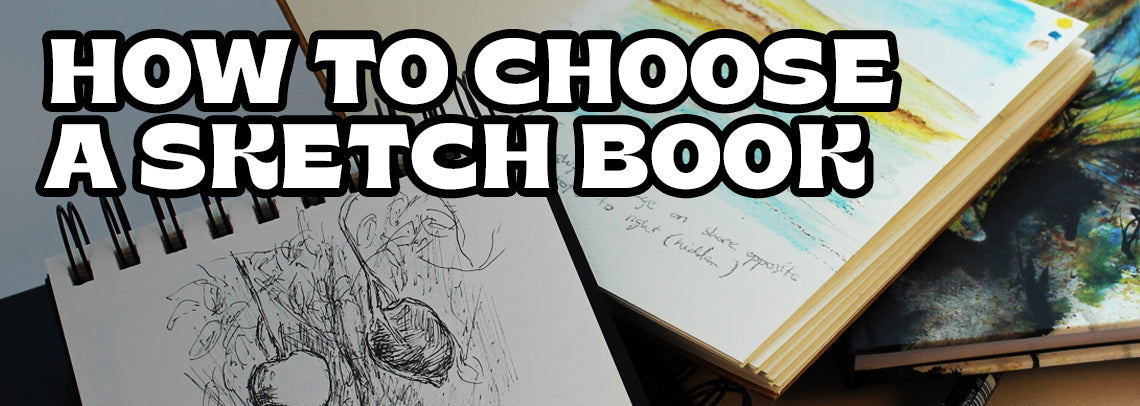If you didn't know already, adopting a regular art practice comes with a number of unbeatable benefits. Sketching and painting can help improve your mood, decrease tension, boost your cognitive functioning, and more.
If you're looking for ways to incorporate an art practice into your regular routine, a good place to start is with a great sketch book. Sketch books are portable and many of them are suitable for a number of mediums ranging from pencil to acrylic paint.
Choosing a great sketch book is a subjective experience and many artists find that it takes a trial process to get it just right. That being said, we can help you understand some of the sketch book characteristics worth considering.
Read on for our guide to different types of sketch books and how to choose one.
Size
Do you know how big your drawings and paintings usually are? This can help you decide on an appropriate size for your sketch book.
If you enjoy creating larger works of art or flash-style doodles, a larger sketch book is naturally the better choice. A sketch book that is 9 inches by 12 inches will do the trick for most artists who prefer a little more space.
Are you looking for something more portable and don't want to carry a bag with you everywhere you go? You can add a pocket-sized sketch book to your collection of supplies. This is a nice way to ensure that you can sketch when inspiration strikes--even on the go.
Size can also refer to the number of pages in a sketch book. Sketch books with one hundred pages or more are great for those work in the same sketch book for months on end or to use the same sketch book as a catch-all for different styles and mediums. Shorter sketch books are better for those who prefer to finish up a sketch book quickly or use different sketch books for specific types of work.
Type and Quality of Paper
Unless you plan to work only in dry mediums like pencil, you're going to want a sketch book with versatile, thick paper. Any liquid-based mediums (like paint or even marker) will require paper with at least 200 grams per square (gsm).
There are a few other things to keep in mind when you're considering different types of paper. For example, a watercolor paper that is referred to as "hot-pressed" is going to have a smooth texture, whereas "cold-pressed" describes paper that has a grainy feel. It's also important to remember that smoother textures are preferable for pencil, as any amount of roughness can dull your tools.
One more thing: while a good sketch book doesn't need to cost a fortune, the cheapest options will come with the lowest-quality paper. You want to make sure that your sketch book contains acid-free paper that will preserve all mediums for years to come.
Cover and Binding
Other sketch book characteristics to consider when making your sketch book selections are the cover material and binding method.
Unless you're looking for something incredibly lightweight, we will almost always suggest that you get a sketch book with a hardcover. A hardcover sketch book is more durable, protecting the integrity of your pages no matter how much you carry it around or pack it away. Plus, a hardcover is going to provide you with a built-in surface to support your sketching or painting process, whereas a softcover may bend or give.
Your preferred binding method is going to be more subjective. There are three commons sketch bookbinding styles: spiral-bound, adhesive-bound, or stitch-bound.
Spiral-bound sketch books are often the easiest to use because they can flip all the way open and give you 100% access to every single page. While adhesive-bound and stitch-bound sketch books have a sleek and attractive appearance, you may find that they're not always easy to open fully. This can become frustrating when you're in the middle of creating something or when you've used a liquid-based medium that needs to dry.
Perforation
If you've purchased notebooks for school before, you've probably come across the difference between perforated and unperforated paper. Perforation refers to the pre-cut line across the inside edge of a piece of paper. It allows you to remove an individual page without having to cut it or tear it away directly from the binding.
If you want to be able to remove your sketches or paintings from your sketch book (perhaps to give away or display), you may enjoy a perforated edge. However, sketch books with perforated paper don't always have as much integrity. In other words, some of your pages may start falling out even when you don't want them to.
Your Intended Use
As you may have gathered, so many of the considerations you can make when choosing a sketch book come down to one thing: how do you intend to use your sketch book?
Starting a sketching practice doesn't have to be complicated. There are plenty of ways to approach your creative practice with specific intentions and parameters that will help you excel in a short period of time. Once you have an idea of the practice you hope to cultivate, you can find the perfect sketch book with ease.
Which Sketch Book Will You Try?
At the end of the day, the perfect sketch book is the one that lets you explore your artistic expressions on your own terms. We hope that our guide to the different sketch book characteristics will lead you to your ideal sketch book!
While you're here, take a look at our full catalog of art supplies and of course our sketch book. Whether you're interested in drawing and painting or textile and three-dimensional art forms, we have the supplies to inspire.







